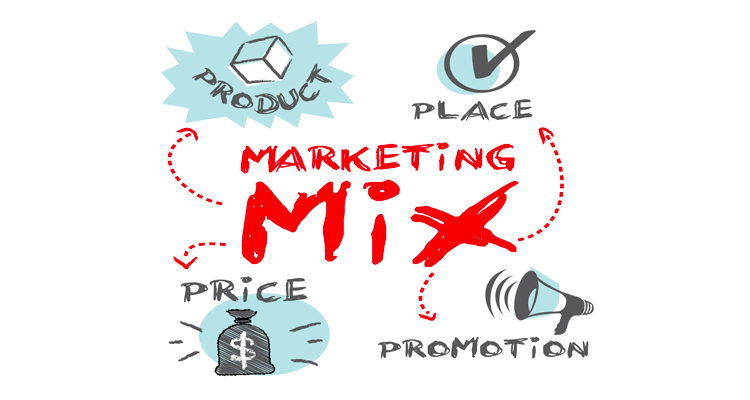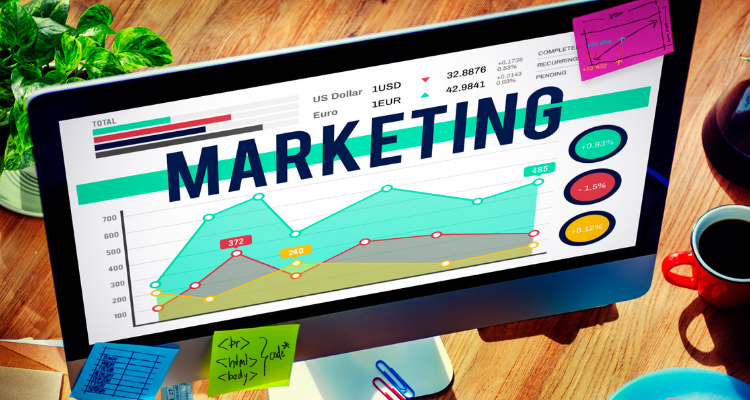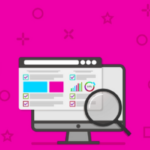An effective marketing mix is all about putting the right product, at the right price, in the right place, with the right promotion, at the right time.
With some knowledge about what the marketing mix actually is, and some handy hints on how to get your marketing mix right, you’ll be on the road to commercial success in no time.
A Definition of the Marketing Mix
Let’s go back a step. It’s fairly pointless launching into a long-winded explanation of how to get your marketing mix right, if we don’t first take a look at what the marketing mix actually is.
The marketing mix is a set of controlled variables that can, and should, be used to formulate the overarching strategic position of your product, service, or brand within the broader marketplace. These variables are often referred to as the four P’s of the marketing mix: Product, Price, Place, and Promotion.
- Product: As one would expect, the first variable is used to describe whatever it is that you are trying to market. This may very well be a physical product, but it could just as easily be a service, a brand, or an experience. Whatever the case may be, the term Product is used to describe all the characteristics of what it is that you are marketing: quality, benefits, packaging, after sale support, customer service. Product is the combination of all the features, advantages, and benefits that you offer to your target market.
- Price: Funnily enough, Price is related to how much you intend to charge for your products or services. It can encompass recommended retail price, discount offers, special deals for industry or trade and credit or lay-buy terms and conditions.
- Place: The third variable of the marketing mix is Place: where and how are your products or services are actually being distributed, bought and sold. Place includes everything from distribution channels, transportation, and logistics, right down to the extent of your market coverage. It really is everything involved in getting your product to your target market.
- Promotion: Promotion refers to the promotional activities that communicate the merits of your product to your target market in an attempt to persuade them to purchase it. It includes a whole raft of options, from marketing and advertising, to promotions and social media.
How to Get Your Marketing Mix Right
Product
To make sure that your Product is the best possible version of itself, there are a number of questions that you should be asking yourself:
- What is the core benefit of your product? For example, customers who buy mobile phones are purchasing so much more than just a phone; they are purchasing the ability to stay in touch with their loved ones. If you are unable to pinpoint the core benefit of your product, then your customers probably can’t either. No benefit = no sale.
- What is it that your product actually includes? The answer to this question might include everything from branding and high-tech features to environmentally friendly packaging. You should be answering this question with a whole lot of features that the products of your competitors don’t offer. It is these points of differentiation that will ensure that customers buy your product, rather than that of your competitor.
- What non-tangible benefits do you provide? Here you should include benefits like outstanding after-service and customer care, free delivery and extended warranties. Again, you should be listing benefits that your competitors don’t provide. Or, at the very least, matching competitor offerings.
- Is there any potential for spin-off products or services? Could you be manufacturing a range of accessories or add-ons? Will have an updated version of your product in 12 months time? Think like Apple. They have a huge range of accessories, and release new hardware and software every year. It’s one of the reasons they are so successful.
Price
Price is a critical part of anyone’s marketing mix. Getting your pricing structure right will ensure that you maximise profits and build strong relationships with your customers. Depending on your position, product type, and brand image, you may opt for a number of different pricing strategies.
- Premium (or Perceived Value) Pricing: this pricing model is usually used when a brand feels that it will provide a substantial competitive advantage for its products. Usually, premium pricing is used for luxury products, by luxury brands. For example, Mercedes Benz, Louis Vuitton and Chanel all employ this pricing method.
- Penetration Pricing: this pricing method can be extremely useful if your product is new to the market. It is a somewhat sneaky pricing tactic: you set a price that is lower than that of your competitors, with the objective of gaining increased market share and securing more sales. Once market share is obtained, you then increase prices to their normal level. It is particularly handy for products that extremely price sensitive (ie. a small price change results in a large change in demand) like milk or bread.
- Competition Pricing: involves setting prices in comparison with your competitors. This is quite a common pricing strategy, and is often used by small businesses in an attempt to avoid price wars with competitors, while still maintaining a stable profits.
- Mark-up Pricing: some first-time retailers use this basic pricing structure. It involves including a standard mark-up on the cost of all products. It has some major drawbacks. It doesn’t take into account demand or competition or any other major economic indicators. We would suggest steering clear of this pricing method where you can.
For more information on pricing, check out our article Harnessing the Power of Pricing.
Place
When it comes to Place, you really need to determine what distribution method is going to be most effective for both your product, and your target market. Being in the right location, at the right time, can play a major part in a customer’s decision-making process. To find out where your ideal customers are buying from, it’s worth undertaking some market research.
Given the need for market research, Place is definitely not a one-approach-suits-all type of scenario. So it can be tricky to provide specific, tailored advice. Keep in mind that there is any number of distribution methods available, and you can use one or a combination of all of them:
- Retailers: companies that sell direct to consumers and retain the option of determining the final price of your product. Retailers can be big (like Myer, or David Jones) or small (like the gift shop in your home town’s main street). There are advantages and disadvantages for opting for retailers. While they carry much of the risk for you (especially inventory overabundance), they can also jack up the price of your product and pocket the profits.
- Wholesalers: these companies purchase merchandise in bulk and then resell it to other businesses and retailers. The pros and cons of opting for a relationship with a wholesaler are very similar to those associated with retailers. The only difference is the end buyer: consumer, or business.
- Agents or brokers: these two entities never take ownership of your product. Instead, they act as intermediaries on your behalf, brokering the sale of your products and then collecting a commission upon the close of sale. Agents and brokers can add an additional cost to your marketing mix, but can also be highly effective in broadening your market share. The trick is finding reputable, effective agents and brokers.
- Online: e-commerce is huge. Through the magic of the internet, you now have access to a much broader, geographically dispersed market. Businesses can reach an infinitely wider audience, with a relatively low setup cost and low ongoing overheads. There is no longer any need to rent out an expensive high-street shop and pay shop assistant salaries. Instead, have a reputable web development company build you a sleek online store and manage it yourself.
Promotion
So, we finally reach what many people consider to be the real (and often only) consideration when it comes to the marketing mix. How will you promote your business, product, service or brand? If you fail to promote your business, it is unlikely that your sales will skyrocket. Promotion is about using the right promotional tactics, at the right time, to attracting the right people to use and re-use your business.
There are two main categories when it comes to Promotion: push marketing (sometimes called outbound marketing) and pull marketing (sometimes called inbound marketing). The difference between the two lies in how customers are approached. As the name suggests, in push marketing, products are pushed onto customers (such as in television and radio advertising and billboards). By contrast, pull marketing is all about establishing a loyal following and drawing customers to your products. This is usually achieved through sharing your knowledge, providing useful advice and information that people want to willingly share. The most important thing when it comes to pull marketing is to ensure that you aren’t treating it in the same way that you would treat a traditional push marketing channel. If you use pull marketing channels (like blogs and social media) to bang on about your latest product, you risk alienating customers forever. Instead, focus on creating value and increasing engagement. There are a number of promotional techniques that can be used, and combined, to create an effective marketing program including:
- Branding (usually push marketing): this is an important promotional technique. The way in which you package up and brand your product or service as a whole is vital. Premium brands will have very different target markets to budget brands. One is not better than the other, simply different. Branding can include any number of techniques, from display signage on vehicles and shop fronts to branded uniforms, packaging, stationary and collateral.
- Public Relations (usually pull marketing): can be a highly effective way of securing ‘free’ editorial coverage. However, the time required to perform effective public relations (such as drafting and distributing media releases, and liaising with journalists) should be kept in mind.
- Advertising (usually push marketing): traditional advertising avenues such as radio, print and television advertising can secure broad, blanket branding coverage for companies that have the budget. And, these days, online advertising avenues are equally as important.
- Content Marketing (usually pull marketing): creating and distributing entertaining, informative or educational content (usually online) with the objective of changing customer opinions or buying habits. The most common form of content marketing is blogging.
- Social Media (usually pull marketing): now a must-have component of any promotional campaign, social media is a popular online form of customer engagement. By now, everyone is familiar with the platforms: Facebook, Twitter, Google+, YouTube, Instagram, Pinterest and LinkedIn.
- e-Marketing (usually push marketing): this promotional tactic is often used in conjunction with content marketing programs these days; blog posts are disseminated, and delivered, directly into customer inboxes all around the globe every single day.
- Search Engine Optimisation: with the meteoric rise of Google, SEO tactics are becoming commonplace in marketing programs for big name brands. This promotional tactic is particularly important if you rely on online leads to generate business.
- Search Engine Marketing: is focused mainly on per pay click (PPC) advertising. In this model, website owners pay the search engines when users click on their ads and arrive at their website. Pay per click ads appear above, and to the right-hand side, of organic search results on a search engine results page.
For more information on Promotion, check out our Top 10 Promotional Tactics article.
A couple of bonus Ps:
People
Don’t neglect the People within your business. After all, they are the face of your business, your ambassadors. They can affect the way that your products and services are marketed every single day. Friendly, attentive staff contribute to happy, satisfied customers that are likely to recommend your business. Surly, unhelpful staff very quickly put customers off your brand. So, make sure that your team of People can provide a unique selling experience; take recruitment and training seriously.
Process
Process encapsulates the entire buying experience that every one of your customers has to navigate. Poorly executed Process can undermine all the other marketing mix variations in one foul swoop. For example, budget airlines often nail Product and Price and Promotion and Place. But, if right at the end of the sale, there are exorbitant fees for baggage and taxes and seat allocation, customers can end up feeling taken advantage of. The Process completely undermines all the other successful marketing mix elements.
If you need a little bit more help, take a look at our Marketing Plans for some more detailed tips and tricks and checkout Marketing.com.au’s handy tools for marketers..
Sally Wood
Latest posts by Sally Wood (see all)
- 6 Free Marketing Plan Templates - July 22, 2018
- The Ultimate Guide to Instagram Advertising - June 23, 2018
- Q&A with Amy Cockerell, Marketing Coordinator at the TAC - October 6, 2016








